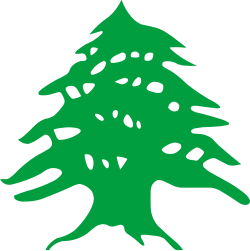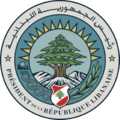| Unofficial coat of arms of Lebanon | |
|---|---|
 Unofficial coat of arms of Lebanon | |
| Armiger | Republic of Lebanon |
| Adopted | 1943 (unofficial) [1] |
| Shield | Gules, on a bend sinister argent a cedar tree palewise vert. |
| Use | Unofficial |
| Unofficial emblem of Lebanon | |
|---|---|
 | |
| Armiger | Republic of Lebanon |
| Adopted | 1943 (unofficial) [1] |
| Shield | a Lebanese cedar tree vert. |
| Use | Lebanese passport, banknotes [2] [3] [4] |
Lebanon never officially adopted a coat of arms or emblem. However, various unofficial coats of arms have been used since the proclamation of independence on 7 December 1943. [1] [5] The main variant consists of a red shield with a white bend sinister on which is placed a cedar tree. It is similar to the flag of Lebanon, with the exception of the Spanish fess on the flag being changed into a bend sinister. [1] [6]
The seals of the Supreme Judicial Council of Lebanon, [7] of the President of the Republic, [8] and of the Republican Guard also feature variants of the unofficial coat of arms. [9]



